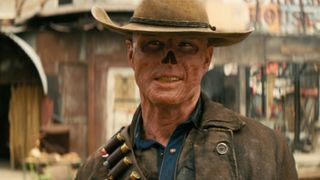Of course Fallout fans are thirsty for The Ghoul—this isn't the first time everyone's fallen for an irradiated guy
If you've accepted yourself as a ghoul lover, let me introduce you to John Hancock.

Everyone thinks that The Ghoul in the new Fallout TV show is hot. Like unanimously. So much so that people are asking the cast if they agree. They pretty much all think so too, aside from Lucy's actress Ella Purnell, who joked: "I mean he doesn't have a nose. You can only fix so much."
That really doesn't seem to be stopping anyone but Purnell though—the internet is thirsty for The Ghoul. If you've been following the show, your social feeds, like mine, have likely been inundated with Ghoul posts, fanart, and relentless fancam edits.
Let's not kid ourselves. If we set aside his face for a second, The Ghoul is the prototypical hot guy of modern television: a bad man with a sad backstory who's really good at what he does, even if (especially if?) what he does is remorselessly torture people. Folks love a competent bad man. As far as ghouls of Fallout go, The Ghoul's actually pretty intact, facially, enough so that I feel like other ghouls could nearly mistake him for a regular old smoothskin. Maybe blood splatter is moisturizing. Let's all just admit that's a conventionally attractive ghoul.
I was reticent to go all fandom on main, but I knew this was coming well before the show aired because this is not the first ghoul that Fallout fans have caught a bad case of rads for. If you happen to be new to the series, please allow me to tell you that this is something of a tradition.

There's no doubt in my mind that The Ghoul was intentionally cast in the mold of a different irradiated fella: Fallout 4's own sad bad boy Hancock, who was also much beloved by fans. Hancock makes his intro in Fallout 4 when you arrive in the crime and vigilante-ridden settlement Goodneighbor. His first act? He stabs a guy in front of you. But the guy was trying to extort you for protection money, so who's the real villain here? Hancock immediately establishes himself as a smooth talker—charismatic and flirtatious with a personal moral compass that demands keeping the peace with occasional violence. He's got a real king of the pirates vibe, despite the landlocked neighborhood.
It feels like we've collectively arrived in our "I won't fix him" era of just admitting that irredeemable evil is hot sometimes.
He has a sad backstory of his own, as is prescribed for maximum internet thirst, in which he and other ghouls were booted out of one of the east coast wasteland's main settlements, Diamond City, due to prejudice against ghouls. After a lot of run-ins with raiders and a fair share of chem benders, conveniently-named John washes up at Boston's Old State House in front of a set of clothes inspired by ol' founding fathers John Hancock and decides to roll with the professional cosplay life, adopt the moniker, and declare himself mayor of Goodneighbor, "by the people for the people," including ghouls.
He was a hit, and it was no mistake that everyone took to Hancock like moths either. Though I imagine some will own up to being ghoul-lovers even earlier in the series, Fallout 4 was the first time that Bethesda had fleshed out a companion romance system in one of its flagship RPGs. You know the kind: Collect your crew of misfits, do their personal quests, get the tragic backstory and a sidequest to help them solve it, and then the kissing. Fallout 4's companion romances didn't hit quite like the BioWare RPGs that I suspect inspired them, but it did manage to attract exactly the audience it was angling for (Sit down, Garrus-enjoyers, I know you still win the inhuman loving olympics). Hancock has his own rather devoted crew producing fan works to this day.
PC Gamer Newsletter
Sign up to get the best content of the week, and great gaming deals, as picked by the editors.

Thirst aside, Hancock also set up a bit of lore that The Ghoul (and my favorite loser Thaddeus) is capitalizing on. Throughout season one, The Ghoul has to keep taking a mysterious drug that apparently prevents him going feral as we've seen happen to so many others. What is it though? We don't know. It's not a concept that was ever in the games, which also play pretty fast and loose with the rules of ghoulification.
Hancock wasn't always a ghoul, he's quick to tell you when you meet him. He found some "experimental radiation drug," and though he glosses over the details, it definitely turned him into a ghoul. We also saw Thaddeus take a drug to heal his smashed foot and it's implied that it may in fact turn him into a ghoul also. Is the same drug behind all three cases?

If Hancock set the mold in 2015, The Ghoul's gone and broken it: Hancock hails from the "I can fix him" era of fandom love for bad dudes, but as of 2024 it feels like we've collectively arrived in our "I won't fix him" era of just admitting that irredeemable evil is hot sometimes. Although we've gotten so much of Cooper's humanizing pre-war backstory and his offer to team up with Lucy at the end of season one, so perhaps the inclination for redemption is no more securely buried than The Ghoul himself was. Maybe you can fix him, sweetheart.
With all this love for the TV show, it's no surprise that people are flocking back to Fallout 4 for their own wasteland adventures. We may not think of it as the best of the series, but Fallout 4 is the best to play today, in our opinion. In case you needed any more convincing, there's the smoochable ghoul for your consideration.

Lauren started writing for PC Gamer as a freelancer in 2017 while chasing the Dark Souls fashion police and accepted her role as Associate Editor in 2021, now serving as the self-appointed chief cozy games enjoyer. She originally started her career in game development and is still fascinated by how games tick in the modding and speedrunning scenes. She likes long books, longer RPGs, has strong feelings about farmlife sims, and can't stop playing co-op crafting games.

Josh Sawyer understands why some fans are annoyed by the treatment of New Vegas in Amazon's Fallout series, but he's not one of them: 'Whatever happens with it, I don’t care'

Coming up with 'skeleton outfits' was one challenge of being the Fallout show's costume designer: 'We dressed skeletons right and left'